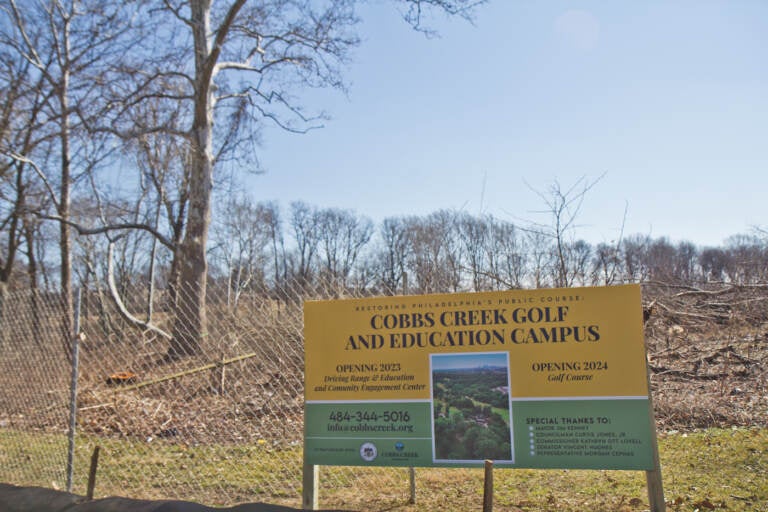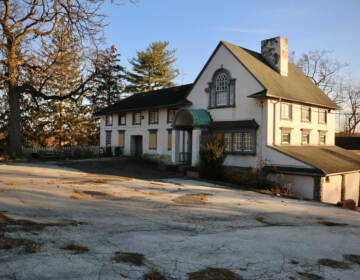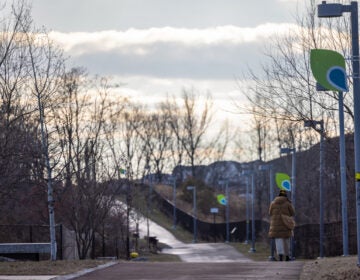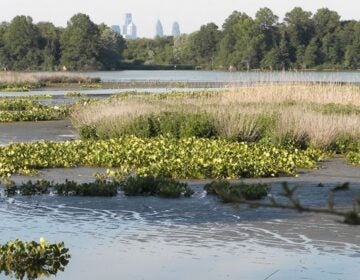Cobbs Creek Golf Course zoning exemption gets commission approval despite opposition
Residents fear the zoning overlay could worsen flooding downstream of the golf course, but a state official and a developer’s contractor say that’s not likely.

File photo: Many trees were felled as part of the restoration and renovation of the Cobbs Creek golf course and community engagement center, as seen on Feb. 27, 2022. (Kimberly Paynter/WHYY)
The Philadelphia City Planning Commission on Thursday voted to approve a zoning overlay that would allow for taller buildings and fences at the Cobbs Creek Golf Course — and exempt the property from site-clearing restrictions on steep slopes typically meant to prevent erosion and runoff.
City Councilmember Curtis Jones Jr., who sponsored the bill in November, introduced another amendment to the controversial zoning overlay Thursday morning, hours before the Planning Commission meeting. That amendment would put a time limit on the steep slope exemption of a year and a half. He said he also wants to specify that impervious surfaces can’t be built on the golf course’s steep slopes, and put commitments around tree planting and flood mitigation in writing.
“Some of my members have raised these issues with me, and we are listening,” Jones said.
The Planning Commission’s vote acts as a recommendation to the council, where the bill still needs to be approved.
The original bill would have fully exempted the golf course from site-clearing restrictions on steep slopes. It also allows for taller buildings, fences, and netting on the property. An amendment made in early December lowered the maximum building height in the proposed overlay from 80 to 50 feet. The Planning Commission voted to approve this December version Thursday.
Representatives of the Cobbs Creek Foundation, the West Conshohocken-based nonprofit renovating the historic Cobbs Creek Golf Course, have said the exemption from steep slope protections is necessary for three elements of the project: mainly, a creek restoration area with steep slopes on the banks of the creek; a retention pond to be used for irrigation; and two golf holes in the historic course design.
The Cobbs Creek Golf Course, built in 1916, was an acclaimed public course that welcomed players of color decades before other courses and the PGA. But in recent years, it fell into disrepair and closed.
The city signed an agreement with the Cobbs Creek Foundation to restore the course to its former glory, with at least $65 million in investments, including a new driving range, restaurant, education center, short course, and 18-hole championship course capable of hosting PGA Tour events. The foundation also plans to rehabilitate the stream banks and beds of over three miles of Cobbs Creek and its tributaries that run through the property, and create dozens of acres of wetlands in an attempt to fix chronic flooding at the site.
Parts of the Cobbs Creek Golf Course project have drawn scrutiny. Last spring, neighbors were surprised to find hundreds of trees clear-cut from the property, raising concerns about erosion, heat, and biodiversity loss. Representatives of the Cobbs Creek Foundation have since vowed to plant 1,500 new trees, shrubs, and other plants in the floodplain, as well as donate $250,000 to TreePhilly to plant hundreds of trees in neighborhoods.
In November, residents learned of the proposed zoning overlay. Residents of the flood-prone Eastwick neighborhood, which sits downstream from the golf course along Cobbs Creek, were particularly alarmed about the exemption from steep slope protections, which they feared could worsen flooding for them.
At a meeting in early December, the Planning Commission requested a 45-day extension to review the bill and give the Cobbs Creek Foundation time for more thorough public outreach. Numerous members of the public spoke in opposition to the overlay, citing concerns over flooding, inadequate community engagement, and tree loss.
But Mike Trumbauer, an ecologist consulting for the Cobbs Creek Foundation, told the Planning Commission Thursday that the renovation of the golf course is an “unlikely source” for downstream flooding issues. He said the golf course makes up just 4% of the Cobbs Creek watershed area, but over a quarter of the “non-urban” land uses — meaning it contributes less runoff than the more developed areas. He said the relative importance of the golf course in the watershed decreases as you move downstream.
“Further downstream they probably would never notice the project happened, the renovation or the creek restoration,” he said.
The creek restoration project will involve removing 20,000 dump trucks full of sediment from the floodplain on the golf course, in order to lower the floodplain elevation and alleviate on-site flooding issues, Trumbauer said. The project should not change the elevation of the 100-year floodplain downstream, he said.
A representative of the Pennsylvania Department of Environmental Protection wrote to the Planning Commission echoing that the project would not negatively impact downstream flooding and could even reduce the amount of water flowing downstream, according to Planning Commission Chair Anne Fadullon. A U.S. Army Corps of Engineers study covering areas downstream of the golf course is not yet finished, Planning Commission staff said.
Jones said Philly’s restrictions on steep slope disturbance were not originally meant to apply to spaces like the golf course.
“[The] intent was to deal with development in places like Manayunk, Roxborough, or East Falls, to stop woodland areas from being overdeveloped,” Jones said Thursday. “It didn’t really match with a golf course.”
Miles Owen, an environmental planner at the Delaware Valley Regional Planning Commission, told WHYY’s PlanPhilly that steep slope protections are fairly common for municipalities to adopt. They generally aim to prevent the increased erosion or fast-moving runoff that can accompany the disruption of steep slopes or the building of impervious surfaces on them, preserve the aesthetics of hills or mountains, or prevent logistically challenging construction. When exemptions to these rules are granted, Owen said, other safeguards are ideally put in place.
“You hope that in granting the variance that a municipality is doing their due diligence and that they’re requiring whoever is doing the project to mitigate all the risks,” he said.
City Council cannot pass bills related to zoning without some recommendation from the Planning Commission, but recommendations are not binding. The Planning Commission usually has about a month to consider legislation after it’s introduced to City Council, but because the commission requested an extension last month, the group had until the end of January to review the Cobbs Creek Golf Course Overlay District.
Corey Wills, a hazard mitigation and resilience planner consulting with Eastwick United CDC, spoke to the Planning Commission Thursday on behalf of a coalition of groups including Cobbs Creek Environmental Justice, HMC Squared Community Association, the Delaware Riverkeeper Network, and the Eastwick Friends and Neighbors Coalition. Wills asked the Planning Commission to delay voting on the zoning overlay, and instead schedule a special meeting to vote at the end of the extended review period.
“The additional 12 days would allow the bill’s proponents to … respond to community concerns,” Wills said.
The coalition wants additional details on earth-moving plans for the steep slope areas, erosion and sedimentation control plans, downstream flood impact analyses, and the effect that tall netting could have on birds and neighbors’ views, Wills said.
Planning Commission Chair Anne Fadullon acknowledged the ongoing concerns around the golf course zoning overlay before all but one commission member voted to accept city staff’s recommendation and approve the bill.
“We heard two-plus hours of public testimony at the last meeting,” Fadullon said. “We got many written comments sent to us. And I think it’s pretty clear that there’s still a lot of concerns from the surrounding community around this.”
Jones said during Thursday’s City Council meeting he expects more conversations and “compromises” to happen within the next week.
“If we need to amend it again, we will amend it again,” he said.
WHYY is your source for fact-based, in-depth journalism and information. As a nonprofit organization, we rely on financial support from readers like you. Please give today.









